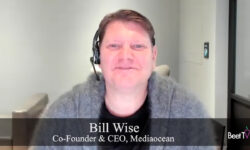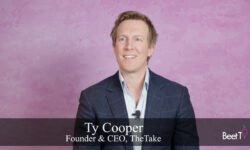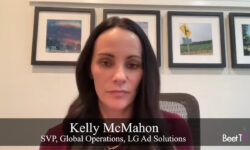In a competitive market, retailers often like to forge their own path. In a digital media world that is increasingly fragmented, that could be a recipe for confusion.
So the media wing of grocery chain Albertsons has taken a brave step, pushing for standardization across the burgeoning retail media arena.
At Cannes Lions in June, Albertsons Media Collective hosted a panel and launched a white paper designed to advocate common approaches in key areas of the new retail media sphere.
In this video interview with Beet.TV at Programmatic IO in New York, Evan Hovorka, VP, Product & Innovation at Albertsons Media Collective, says: “We’re proud to announce that we’re moving our standardization framework over to the IAB.”
Calling IAB to retail media
Albertsons’ push is to head off a proliferation of ad formats and approaches retail media networks (RMNs) have been using on their own platforms.
Although the category has grown fast, Hovorka believes divergence will limit growth. Albertsons thinks standardization could add an extra $5 billion to $15 billion in extra value over three years.
“Retail media networks today have very different methodologies, very different access patterns, even in terms of how you might pay an IO or how you might execute a search campaign,” Hovorka says. “The simpler we make that, the lower the friction points are for our agency and CPG partners.”
He adds the IAB is “the right agency” to take the effort forard: “They’re going to accept that and push that forward to the industry, which makes perfect sense.”
Led by Claire Wyatt (@Albertsons Media Collective) and #IAB’s Jeffrey Bustos, the second interactive breakout session at #IABConnectedCommerce Summit inspired conversations on the crucial topic of standardization in #RetailMediaNetworks pic.twitter.com/5yf6PLEFil
— IAB (@iab) September 13, 2023
Albertsons’ framework
Albertsons’ “Retail Media Standardization Framework” focuses on four areas:
- Product specifications.
- Performance measurement.
- Third-party verification.
- Capabilities.
It calls on other retail media networks to standardize specifications, methodologies, terminology and disclosures.
The framework “recommends RMNs adhere to existing digital media guidelines published by the Interactive Advertising
Bureau (IAB)” (display ads, native ads, new media experiences, digital video and CTV).
Gaining adoption
Getting retail media networks to dispense with custom offerings may prove difficult in some quarters, particularly when it comes to ushering-in third-party verification on aspects like viewability measurement.
After all, retailers see their own customer data as a key leverage in media networks.
But ad buyer pressure, plus the potential upside for RMNs, could be enough to encourage alignment.
Hovorka explains how divergence may hold things back: “If Pepsi’s looking for their VIP consumer, they have to go redefine that 17 different times.”
A solution may be allowing RMNs to go on offering their own signals while translating them to a smaller, subset of buyer-facing options: “There could be an industry definition of what that is – a macro definition that turns into different audiences for each RMN.”
This interview was conducted at AdExchanger’s Programmatic IO event in New York on September 26, 2023.














































